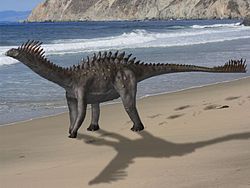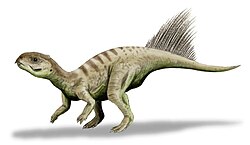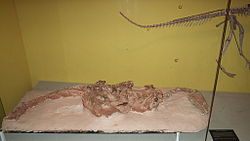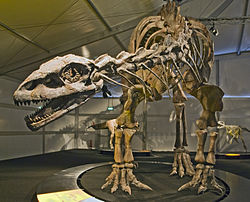| Name | Novelty | Status | Authors | Age | Unit | Location | Notes | Images |
|---|
Amplibuteo concordatus [47] | Sp. nov. | Valid | Steven D. Emslie Nicholas J. Czaplewski | Late Pliocene | Florida and Arizona |  USA: USA:
 Florida; Florida;
 Arizona Arizona
| An Accipitridae. | |
Anatalavis oxfordi [48] | Sp. nov. | Valid | Storrs L. Olson | Early Eocene | Ypresian, London Clay, MP 8 |  UK: UK:
 England England
| An Anseranatidae, Anatalavinae Olson, 1999. In 2002 Jíří Mlíkovský made this species the type species of his not widely accepted new genus Nettapterornis. [49] | |
Aquila bivia [47] | Sp. nov. | Valid | Steven D. Emslie Nicholas J. Czaplewski | Late Pliocene | Florida |  USA: USA:
 Florida; Florida;
 Arizona Arizona
| An Accipitridae. | |
Argornis caucasicus [50] | Gen. nov. et Sp. nov. | Valid | Aleksandr A. Karkhu | Late Eocene | Northern Caucasus |  Russia Russia
| An Apodiformes, Jungornithidae Karkhu, 1988. | |
Canadaga arctica [51] | Gen. nov. et Sp. nov. | Valid | Hou Lianhai | Late Cretaceous | Middle Maastrichtian |  Canada: Canada:
 Nunavut Nunavut
| A Hesperornithidae Marsh, 1872. | |
Changchengornis hengdaoziensis [52] | Gen. nov. et Sp. nov. | Valid | Ji Qiang Luis M. Chiappe Ji Shu’an | Early Cretaceous | Chaomidianzi Formation |  China China
| A Confuciusornithidae Hou, Zhou, Gu et Zhang, 1995. | |
Chaunoides antiquus [53] | Sp. nov. | Valid | Herculano M. F. de Alvarenga | Late Oligocene or Early Miocene | Tremembé Formation |  Brazil Brazil
| An Anhimidae. | |
Chauvireria bulgarica [54] | Sp. nov. | Valid | Boev | Pleistocene | |  Bulgaria Bulgaria
| A Phasianidae. | |
Confuciusornis dui [55] | Sp. nov. | Valid | Hou Lianhai Larry D. Martin Zhou Zhonghe Alan Feduccia Zhang Fucheng | Early Cretaceous | Yixian Formation |  China China
| A Confuciusornithidae Hou, Zhou, Gu et Zhang, 1995. | |
Dryolimnas augusti [56] | Sp. nov. | Valid | Cécile Mourer-Chauviré Roger Bour Sonia Ribes François Moutou | Holocene | Réunion |  Réunion Réunion
| A Rallidae. | |
Emberiza alcoveri [57] | Sp. nov. | Valid | J. C. Rando M. Lopez B. Seguí | Late Pleistocene-Holocene | Canary Islands, Tenerife |  Spain: Spain:
 Canary Islands Canary Islands
| An Emberizidae. | |
Eocuculus cherpinae [58] | Gen. nov. et Sp. nov. | Valid | Robert M. Chandler | Late Eocene | Early Chadronian |  USA: USA:
 Colorado Colorado
| A ?Cuculidae. | |
Eoenantiornis buhleri [59] | Gen. nov. et Sp. nov. | Valid | Hou Lianhai Larry D. Martin Zhou Zongzhe Alan Feduccia | Early Cretaceous | Yixian Formation |  China China
| An Enantiornithes Walker, 1981, Eoenantiornithiformes Hou, Martin, Zhou et Feduccia, 1999, Eoenantiornithidae Hou, Martin, Zhou et Feduccia, 1999, this is the type species of the new genus. | |
Falco bakalovi [60] | Sp. nov. | Valid | Zlatozar N. Boev | Late Pliocene | Villafranchian, MN 17 |  Bulgaria Bulgaria
| A Falconidae. | |
Gallinula balcanica [61] | Sp. nov. | Valid | Zlatozar N. Boev | Late Pliocene | Villafranchian, MN 17 |  Bulgaria Bulgaria
| A Rallidae. | |
Graculavus augustus [62] | Sp. nov. | Valid | Sylvia Hope | Late Cretaceous | Late Maastrichtian, Lance Formation |  USA: USA:
 Wyoming Wyoming
| A Graculavidae Fürbringer, 1888. | |
Gurilynia nessovi [63] | Gen. nov. et Sp. nov. | Valid | Evgeny N. Kurochkin | Late Cretaceous | Gurilyn Tsav |  Mongolia Mongolia
| An Enantiornithes Walker, 1981, Alexornithiformes Brodkorb, 1976, Enantiornithidae Nessov & Borkin, 1983. | |
Hebeiornis fengningensis [64] | Gen. nov. et Sp. nov. | Valid | Yan | Early Cretaceous | Yixian Formation |  China China
| Ornithothoraces Chiappe et Calvo, 1994, this is the type species of the new genus. Vescornis hebeiensis Zhang, Ericson et Zhou, 2004. is a junior synonym. [65] | |
Liaoxiornis delicatus [66] | Gen. nov. et Sp. nov. | Valid | Hou Lianhai Chen Peiji | Early Cretaceous | Yixian Formation |  China China
| A Liaoxiornithidae L. H. Hou et Chen, 1999, this is the type species of the new genus. Lingyuanornis parvus Ji & Ji, 1999. is a junior synonym. [67] | |
Longmornis robustirostrata [68] | Gen, nov. et Sp. nov. | Valid | Walter E. Boles | ?Early Miocene | Riversleigh |  Australia: Australia:
 Queensland Queensland
| An Oriolidae, this is the type species of the new genus. | |
Loxia patevi [69] | Sp. nov. | Valid | Zlatozar N. Boev | Late Pliocene | MN 17 |  Bulgaria Bulgaria
| A Fringillidae. | |
Masillapodargus longipes [70] | Gen. nov. et Sp. nov. | Valid | Gerald Mayr | Middle Eocene | Messel pit, MP 11 |  Germany: Germany:
 Hessen Hessen
| A stem Podargidae, this is the type species of the new genus. | |
Ngawupodius minya [71] | Gen. nov. et Sp. nov. | Valid | Walter E. Boles Tessa J. Ivison | Late Oligocene | Namba Formation |  Australia: Australia:
 South Australia South Australia
| A stem Megapodiidae, this is the type species of the new genus. | |
Nupharanassa bohemica [72] | Sp. nov. | Valid ? | Jirí Mlíkovský | Early Miocene | MN 4b |  Czech Republic Czech Republic
| A Jacanidae. Mourer-Chauviré, 1999 transferred this species to the genus Geranopterus Milne-Edwards, 1892 and later it was placed in the Geranopteridae Mayr & Mourer-Chauviré, 2000. [73] | |
Paraprefica kelleri [70] | Gen. nov. et Sp. nov. | Valid | Gerald Mayr | Middle Eocene | Messel pit, MP 11 |  Germany: Germany:
 Hessen Hessen
| A stem Nyctibiidae, this is the type species of the new genus. | |
Paraprefica major [70] | Sp. nov. | Valid | Gerald Mayr | Middle Eocene | Messel pit, MP 11 |  Germany: Germany:
 Hessen Hessen
| A stem Nyctibiidae. | |
Pelecanus schreiberi [74] | Sp. nov. | Valid | Strorrs L. Olson | Early Pliocene | Yorktown Formation |  USA: USA:
 North Carolina North Carolina
| A Pelecanidae. | |
Primotrogon wintersteini [75] | Gen. nov. et Sp. nov. | Valid | Gerald Mayr | Middle Oligocene | MP 23 |  France France
| A stem Trogonidae, the type species of the new genus. | |
Pumiliornis tessellatus [76] | Gen. nov. et Sp. nov. | Valid | Gerald Mayr | Middle Eocene | Messel pit, MP 11 |  Germany: Germany:
 Hessen Hessen
| Order and family Incerta Sedis, the type species of the new genus. | |
Regulus bulgaricus [77] | Sp. nov. | Valid | Zlatozar N. Boev | Late Pliocene | MN 17 |  Bulgaria Bulgaria
| A Regulidae. | |
Scolopax carmesinae [78] | Sp. nov. | Valid | Bartomeu Seguí | Late Pliocene | Menorca, MN 17-18 |  Spain: Spain:
 Menorca Menorca
| A Scolopacidae. | |
Selmes absurdipes [79] | Gen. nov. et Sp. nov. | Valid | Dieter S. Peters | Middle Eocene | Messel pit, MP 11; MP 13 |  Germany: Germany:
 Hessen; Hessen;
 Saxony-Anhalt Saxony-Anhalt
| A Coliiformes, Selmeidae Zelenkov et Dyke, 2008, the type species of the new genus. | |
Tyto neddi [80] | Sp. nov. | Valid | David W. Steadman William B. Hilgartner | Late Pleistocene-Early Holocene | Barbuda |  Antigua and Barbuda Antigua and Barbuda
| A Tytonidae. | |
Yandangornis longicaudus [81] | Gen. nov. et Sp. nov. | Valid | Cai Zhengquan Zhao Lijun | Early Late Cretaceous | Santonian |  China China
| An Enentiornithes, this is the type species of the new genus. | |
|
























